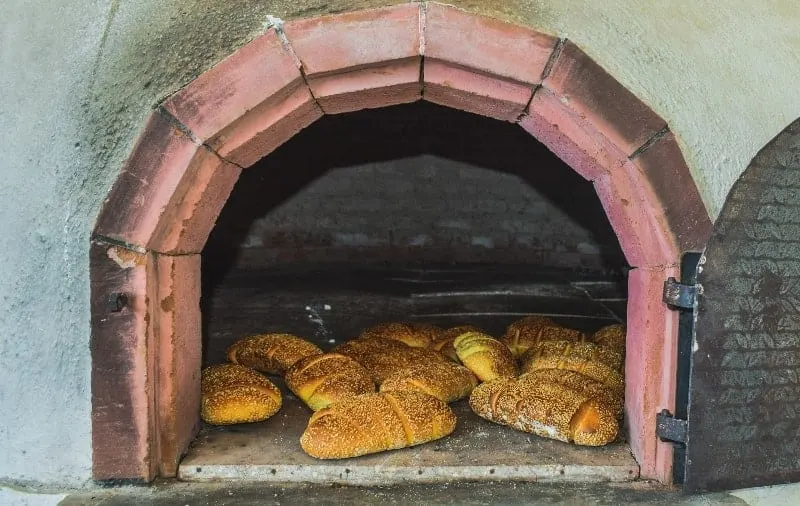A huge question asked when baking bread is what kind of oven to use. If you’re from the UK like me, you’ll likely run into issues with recipes whenever you’re using your fan oven for anything. Since most US recipes don’t specify the type of oven to use, you’re often left guessing what temperature to use.
Some people recommend using fan assisted ovens whilst others recommend non-fan ovens. The truth is that it doesn’t matter. As long as you understand how your oven works and how to adjust the temperature, your bread will bake nicely.
Whether it’s a fan (convection) or non-fan (conventional) oven, you can cook great bread in both. Fan ovens cook faster than non-fan do since they distribute heat better, so you should make up for this by lowering the temperature by 20°C. You can cook bread in either oven as long as you know your oven well.
I’m very fortunate to own a multifunctional oven that has both a fan oven and a non-fan oven, so I’ve been able to try out both many different times. I’ve tested both of them with the same bread and it bakes nearly exactly the same in both but can bake slightly faster in the fan.
Personally, I prefer to use a fan oven, but that’s just because I use it for almost everything else I cook. I have no problems with non-fan ovens whatsoever. I’ll occasionally use the non-fan oven if a recipe calls for it or if I feel like using it, but it’s not often.
How Do The Two Ovens Compare?
So you want to know more about the two ovens? Okay, let’s go into a bit more detail and compare how effective the two are at baking bread.
Just know that you can get away with baking bread in either oven. You don’t need to spend any extra money on a new oven to bake lovely bread.
Fan Oven
Convection (fan) ovens can actually be better at baking bread, especially if you’re baking multiple loaves at once. Since the heat is more consistent and there is a lower risk of hot or cold spots, you don’t have to worry about turning your loaves around or adjusting them at any point.
Just make sure that you’re knocking the temperature down a good 20°C if you’re using a fan oven.
Some say that fan ovens can dry your bread out more since they are more likely to lose steam. Personally, I haven’t experienced dryness in my fan oven since I almost always add steam to my bakes, but every oven is different and some may be drier than others.
One thing to note about fan ovens is that they can cook slightly faster. They can cook up to 25% faster, but I don’t always notice that my bread cooks considerably faster.
It’s a good idea to check your bread around 10-15 minutes before the end of the recommended baking time. Look for fast browning or take its temperature with a thermometer. You may overcook your bread if you’re not careful.
Assuming that you have a fan oven that’s well made and has even heat, it’ll do a great and maybe even a better job at baking your bread.
Non-Fan Oven
A lot of people own non-fan (conventional) ovens, especially in the US, so a lot of recipes go by the standard non-fan oven temperatures.
This is one of the benefits of using a conventional oven. As long as you’re following a US recipe, you’re most likely going to need a conventional oven.
This takes the guesswork out of so many recipes and you don’t risk baking your bread too quickly.
A problem with conventional ovens is their tendency to have hot or cold spots. Some parts of the oven may tend to be very hot and overcook or burn your bread whilst others will leave your bread doughy.
Some hot spots can even get so hot that they bake part of your bread too quickly and stop it from rising properly, so you can be left with a wonky loaf.
Make sure you can identify any potential hot or cold spots in your oven and avoid baking your bread in them. Look for an area with a consistent temperature for baking.
A Potential Problem With Either Oven
A great technique to keeping your bread moist as well as ensuring that it rises properly is to make sure it gets plenty of steam.
When there’s lots of steam in the oven with your bread, it’s going to get a great oven spring and it won’t brown too quickly, so it’s important to not allow your oven to get dry.
One important thing to have on an oven is a good seal. If the seal between the oven door and the oven isn’t tight enough to hold in steam, you’re going to lose that precious moisture and your bread isn’t going to be as good as it should.
Make sure to check your oven seal by pouring some boiling water into a baking tray in a hot oven and watching for steam escaping from the door.
If there’s no steam escaping, your bread should rise tall and mighty.

